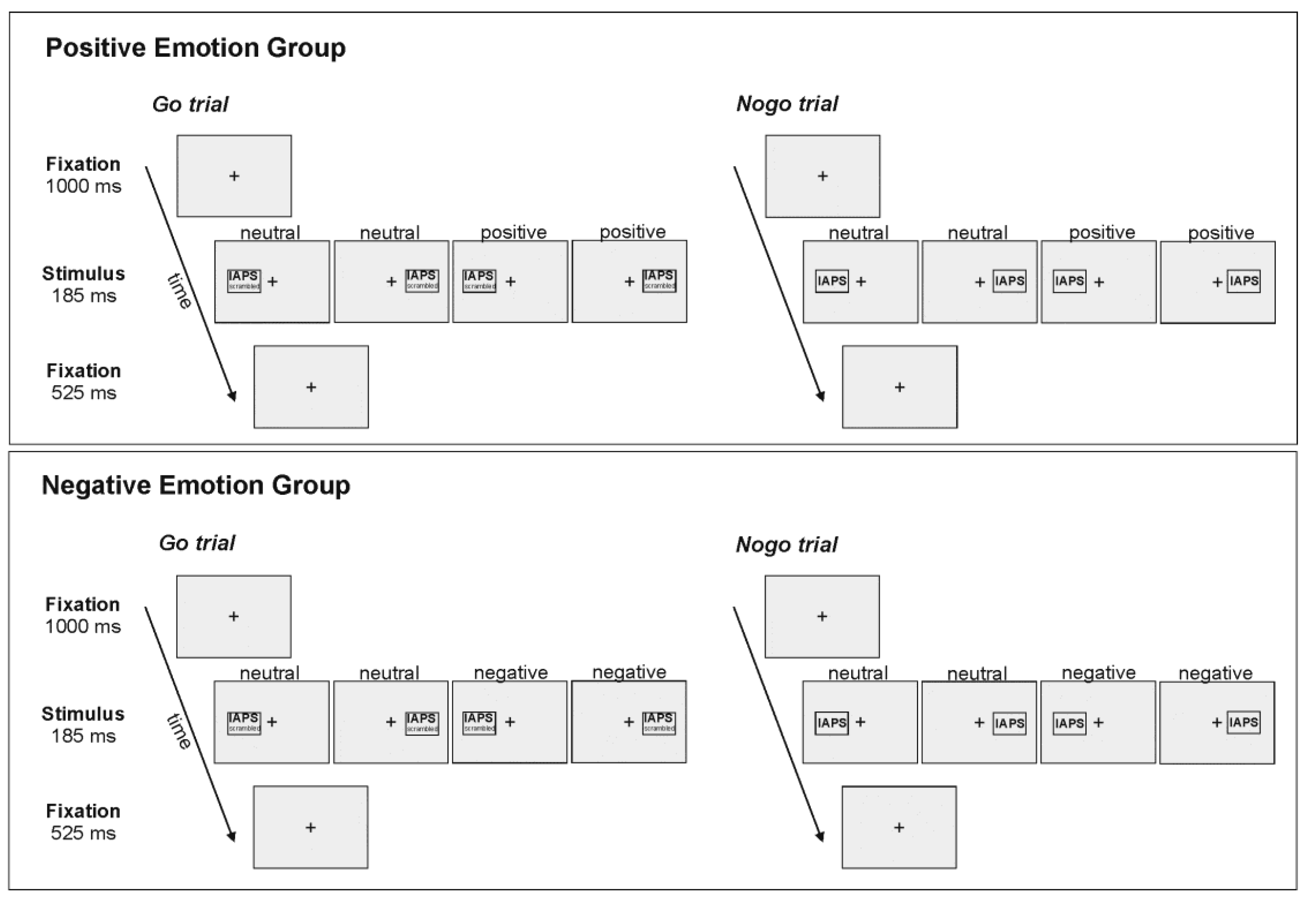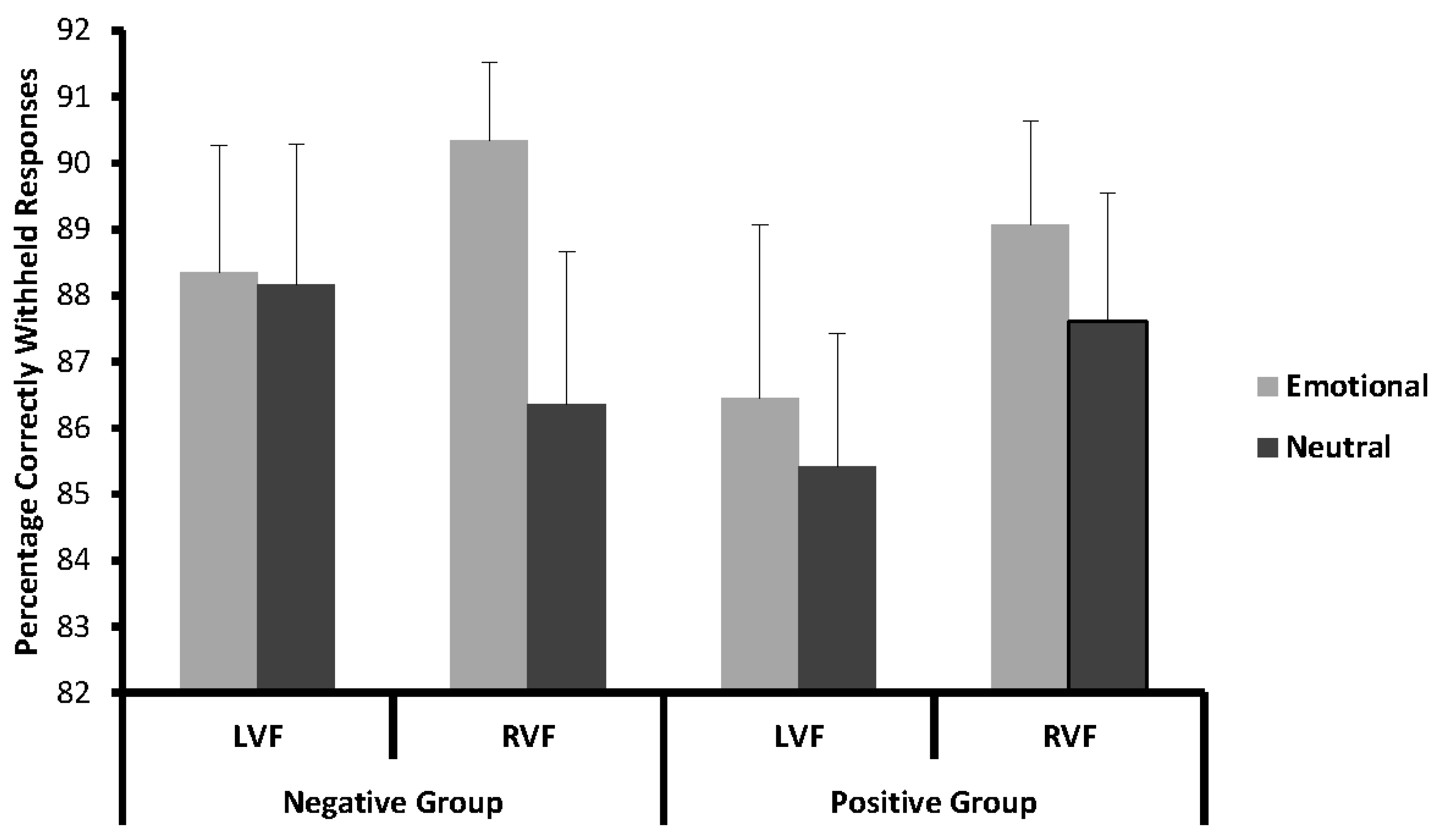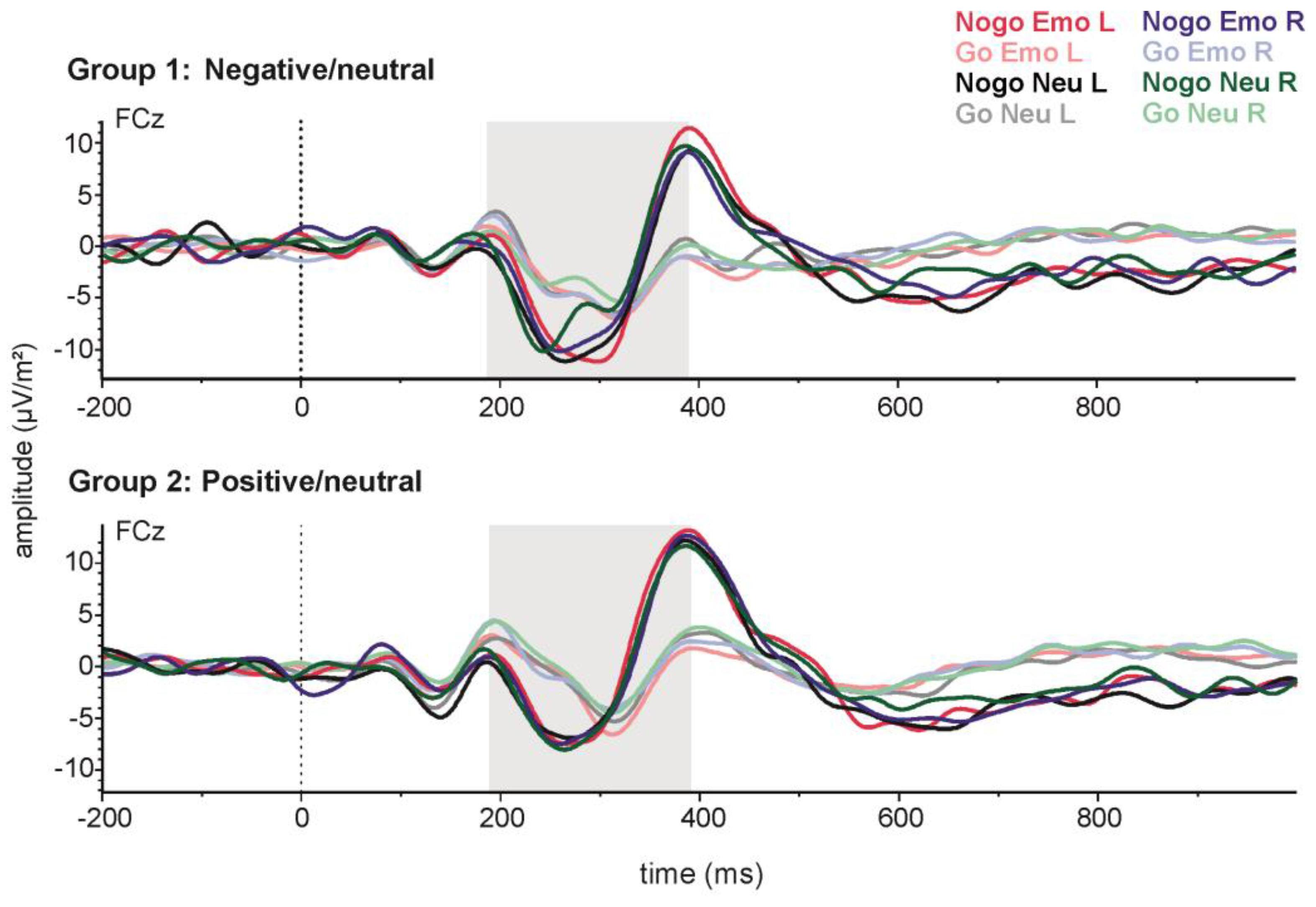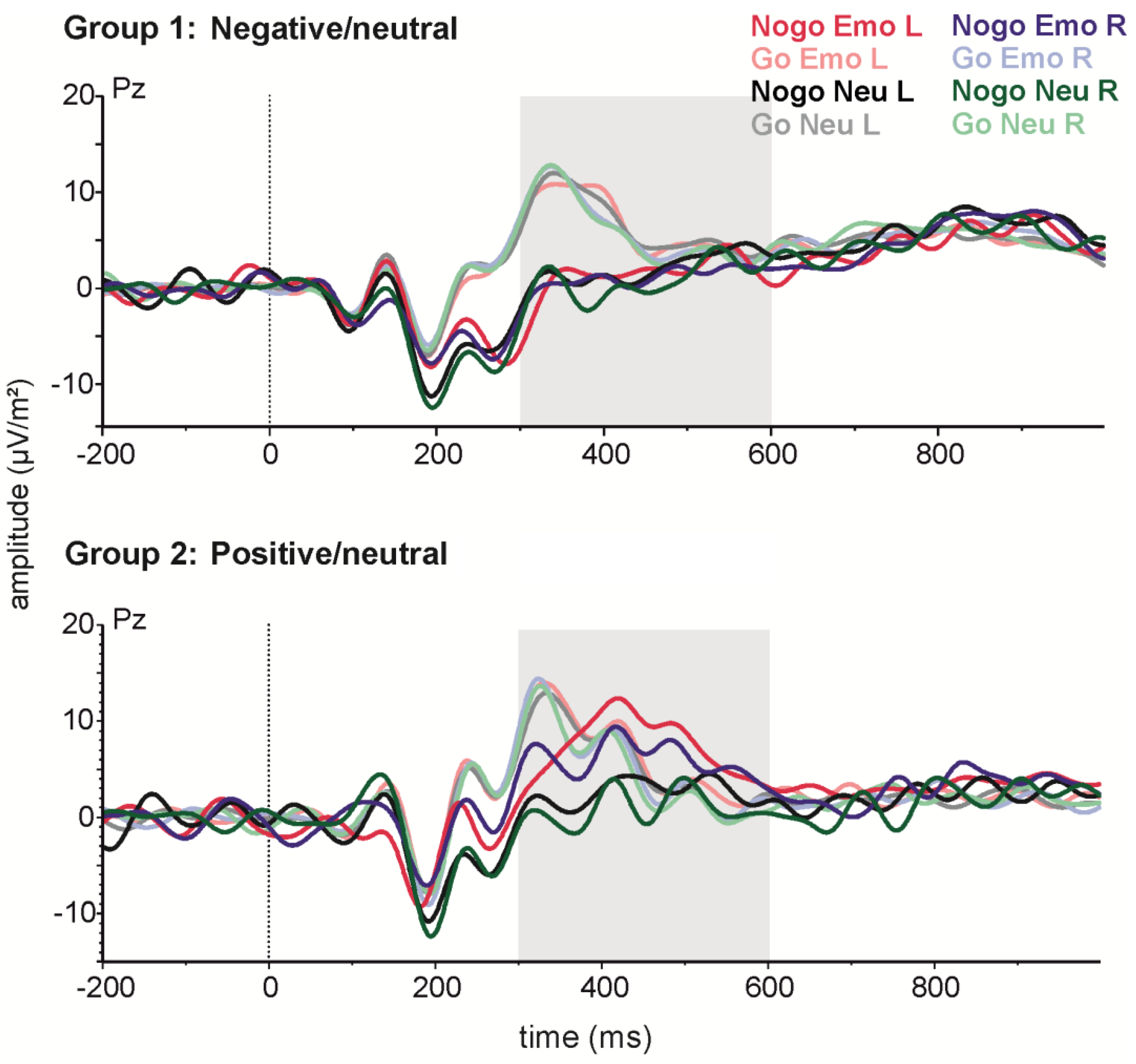Effects of Emotional Valence on Hemispheric Asymmetries in Response Inhibition
Abstract
:1. Introduction
2. Materials and Methods
2.1. Subjects
2.2. Experimental Task
2.3. Electrophysiological Recordings
2.4. Statistical Analysis
3. Results
3.1. Behavioural Data
3.2. EEG Data
3.2.1. N2
N2 Amplitude
N2 Latency
3.2.2. P3
P3 Amplitude
P3 Latency
4. Discussion
5. Conclusions
Acknowledgments
Author Contributions
Conflicts of Interest
References
- Rogers, L.J. Asymmetry of brain and behavior in animals: Its development, function, and human relevance. Genesis 2014, 52, 555–571. [Google Scholar] [CrossRef] [PubMed]
- Rogers, L.J. Development and function of lateralization in the avian brain. Brain Res. Bull. 2008, 76, 235–244. [Google Scholar] [CrossRef] [PubMed]
- Vallortigara, G.; Rogers, L.J. Survival with an asymmetrical brain: Advantages and disadvantages of cerebral lateralization. Behav. Brain Sci. 2005, 28, 575–589. [Google Scholar] [CrossRef] [PubMed]
- Ocklenburg, S.; Ströckens, F.; Güntürkün, O. Lateralisation of conspecific vocalisation in non-human vertebrates. Laterality 2013, 18, 1–31. [Google Scholar] [CrossRef] [PubMed]
- Ströckens, F.; Güntürkün, O.; Ocklenburg, S. Limb preferences in non-human vertebrates. Laterality 2013, 18, 536–575. [Google Scholar] [CrossRef] [PubMed]
- Davidson, R.J. Anterior cerebral asymmetry and the nature of emotion. Brain Cogn. 1992, 20, 125–151. [Google Scholar] [CrossRef]
- Onal-Hartmann, C.; Pauli, P.; Ocklenburg, S.; Güntürkün, O. The motor side of emotions: Investigating the relationship between hemispheres, motor reactions and emotional stimuli. Psychol. Res. 2012, 76, 311–316. [Google Scholar] [CrossRef] [PubMed]
- Thompson, J.K. Right brain, left brain; left face, right face: Hemisphericity and the expression of facial emotion. Cortex 1985, 21, 281–299. [Google Scholar] [CrossRef]
- Hughlings-Jacckson, J. On affections of speech from disease of the brain. Brain 1878, 1, 304–330. [Google Scholar] [CrossRef]
- Gainotti, G. Emotional behavior and hemispheric side of the lesion. Cortex 1972, 8, 41–55. [Google Scholar] [CrossRef]
- Borod, J.C.; Cicero, B.A.; Obler, L.K.; Welkowitz, J.; Erhan, H.M.; Santschi, C.; Grunwald, I.S.; Agosti, R.M.; Whalen, J.R. Right hemisphere emotional perception: Evidence across multiple channels. Neuropsychology 1998, 12, 446–458. [Google Scholar] [CrossRef] [PubMed]
- Coan, J.A.; Allen, J.J.B. Frontal EEG asymmetry as a moderator and mediator of emotion. Biol. Psychol. 2004, 67, 7–49. [Google Scholar] [CrossRef] [PubMed]
- Harmon-Jones, E.; Gable, P.A. On the role of asymmetric frontal cortical activity in approach and withdrawal motivation: An updated review of the evidence. Psychophysiology 2017. [Google Scholar] [CrossRef] [PubMed]
- Ley, R.G.; Bryden, M.P. Hemispheric differences in processing emotions and faces. Brain Lang. 1979, 7, 127–138. [Google Scholar] [CrossRef]
- Grimshaw, G.M.; Séguin, J.A.; Godfrey, H.K. Once more with feeling: The effects of emotional prosody on hemispheric specialisation for linguistic processing. J. Neurol. 2009, 22, 313–326. [Google Scholar] [CrossRef]
- Buchanan, T.W.; Lutz, K.; Mirzazade, S.; Specht, K.; Shah, N.J.; Zilles, K.; Jäncke, L. Recognition of emotional prosody and verbal components of spoken language: An fMRI study. Brain Res. Cogn. Brain Res. 2000, 9, 227–238. [Google Scholar] [CrossRef]
- Herrington, J.D.; Heller, W.; Mohanty, A.; Engels, A.S.; Banich, M.T.; Webb, A.G.; Miller, G.A. Localization of asymmetric brain function in emotion and depression. Psychophysiology 2010, 47, 442–454. [Google Scholar] [CrossRef] [PubMed]
- Borod, J.C.; Kent, J.; Koff, E.; Martin, C.; Alpert, M. Facial asymmetry while posing positive and negative emotions: Support for the right hemisphere hypothesis. Neuropsychologia 1988, 26, 759–764. [Google Scholar] [CrossRef]
- Canli, T.; Desmond, J.E.; Zhao, Z.; Glover, G.; Gabrieli, J.D. Hemispheric asymmetry for emotional stimuli detected with fMRI. Neuroreport 1998, 9, 3233–3239. [Google Scholar] [CrossRef] [PubMed]
- Davidson, R.J.; Ekman, P.; Saron, C.D.; Senulis, J.A.; Friesen, W.V. Approach-withdrawal and cerebral asymmetry: Emotional expression and brain physiology. I. J. Pers. Soc. Psychol. 1990, 58, 330–341. [Google Scholar] [CrossRef] [PubMed]
- Silberman, E.K.; Weingartner, H. Hemispheric lateralization of functions related to emotion. Brain Cogn. 1986, 5, 322–353. [Google Scholar] [CrossRef]
- Rodway, P.; Schepman, A. Valence specific laterality effects in prosody: Expectancy account and the effects of morphed prosody and stimulus lead. Brain Cogn. 2007, 63, 31–41. [Google Scholar] [CrossRef] [PubMed]
- Schepman, A.; Rodway, P.; Geddes, P. Valence-specific laterality effects in vocal emotion: Interactions with stimulus type, blocking and sex. Brain Cogn. 2012, 79, 129–137. [Google Scholar] [CrossRef] [PubMed]
- Killgore, W.D.S.; Yurgelun-Todd, D.A. The right-hemisphere and valence hypotheses: Could they both be right (and sometimes left)? Soc. Cogn. Affect. Neurosci. 2007, 2, 240–250. [Google Scholar] [CrossRef] [PubMed]
- Heller, W. Neuropsychological mechanisms of individual differences in emotion, personality, and arousal. Neuropsychology 1993, 7, 476–489. [Google Scholar] [CrossRef]
- Heller, W.; Nitschke, J.B.; Miller, G.A. Lateralization in emotion and emotional disorders. Curr. Dir. Psychol. Sci. 1998, 7, 26–32. [Google Scholar] [CrossRef]
- Harmon-Jones, E.; Gable, P.A.; Peterson, C.K. The role of asymmetric frontal cortical activity in emotion-related phenomena: A review and update. Biol. Psychol. 2010, 84, 451–462. [Google Scholar] [CrossRef] [PubMed]
- Grimshaw, G.M.; Carmel, D. An asymmetric inhibition model of hemispheric differences in emotional processing. Front. Psychol. 2014, 5, 489. [Google Scholar] [CrossRef] [PubMed] [Green Version]
- Kane, M.J.; Engle, R.W. The role of prefrontal cortex in working-memory capacity, executive attention, and general fluid intelligence: An individual-differences perspective. Psychon. Bull. Rev. 2002, 9, 637–671. [Google Scholar] [CrossRef] [PubMed]
- Falkenstein, M. Inhibition, conflict and the Nogo-N2. Clin. Neurophysiol. 2006, 117, 1638–1640. [Google Scholar] [CrossRef] [PubMed]
- Garavan, H.; Ross, T.J.; Murphy, K.; Roche, R.A.P.; Stein, E.A. Dissociable executive functions in the dynamic control of behavior: Inhibition, error detection, and correction. NeuroImage 2002, 17, 1820–1829. [Google Scholar] [CrossRef] [PubMed]
- Falkenstein, M.; Hoormann, J.; Hohnsbein, J. ERP components in Go/Nogo tasks and their relation to inhibition. Acta Psychol. 1999, 101, 267–291. [Google Scholar] [CrossRef]
- Bokura, H.; Yamaguchi, S.; Kobayashi, S. Electrophysiological correlates for response inhibition in a Go/NoGo task. Clin. Neurophysiol. 2001, 112, 2224–2232. [Google Scholar] [CrossRef]
- Nieuwenhuis, S.; Yeung, N.; van den Wildenberg, W.; Ridderinkhof, K.R. Electrophysiological correlates of anterior cingulate function in a go/no-go task: Effects of response conflict and trial type frequency. Cogn. Affect. Behav. Neurosci. 2003, 3, 17–26. [Google Scholar] [CrossRef] [PubMed] [Green Version]
- Band, G.P.; van Boxtel, G.J. Inhibitory motor control in stop paradigms: Review and reinterpretation of neural mechanisms. Acta Psychol. 1999, 101, 179–211. [Google Scholar] [CrossRef]
- Beste, C.; Saft, C.; Andrich, J.; Gold, R.; Falkenstein, M. Response inhibition in Huntington’s disease-a study using ERPs and sLORETA. Neuropsychologia 2008, 46, 1290–1297. [Google Scholar] [CrossRef] [PubMed]
- Beste, C.; Dziobek, I.; Hielscher, H.; Willemssen, R.; Falkenstein, M. Effects of stimulus-response compatibility on inhibitory processes in Parkinson’s disease. Eur. J. Neurosci. 2009, 29, 855–860. [Google Scholar] [CrossRef] [PubMed]
- Roche, R.A.P.; Garavan, H.; Foxe, J.J.; O’Mara, S.M. Individual differences discriminate event-related potentials but not performance during response inhibition. Exp.Brain Res. 2005, 160, 60–70. [Google Scholar] [CrossRef] [PubMed]
- Liu, L.; Ioannides, A.A. Emotion separation is completed early and it depends on visual field presentation. PLoS ONE 2010, 5, e9790. [Google Scholar] [CrossRef] [PubMed]
- Rigoulot, S.; D’Hondt, F.; Honoré, J.; Sequeira, H. Implicit emotional processing in peripheral vision: Behavioral and neural evidence. Neuropsychologia 2012, 50, 2887–2896. [Google Scholar] [CrossRef] [PubMed]
- Rigoulot, S.; Delplanque, S.; Despretz, P.; Defoort-Dhellemmes, S.; Honoré, J.; Sequeira, H. Peripherally presented emotional scenes: A spatiotemporal analysis of early ERP responses. Brain Topogr. 2008, 20, 216–223. [Google Scholar] [CrossRef] [PubMed]
- Ocklenburg, S. Tachistoscopic viewing and dichotic listening. In Lateralized Brain Functions: Methods in Human and Non-human Species; Rogers, L.J., Vallortigara, G., Eds.; Humana Press; Springer: New York, NY, USA, 2017; Volume 122. [Google Scholar]
- Lang, P.J.; Bradley, M.M.; Cuthbert, B.N. Motivated attention: Affect, activation, and action. In Attention and Orienting: Sensory and Motivational Processes; Lang, P.J., Simons, R.F., Balaban, M., Eds.; Lawrence Erlbaum Associates: Mahwah, NJ, USA, 1997; pp. 97–135. [Google Scholar]
- Albert, J.; López-Martín, S.; Carretié, L. Emotional context modulates response inhibition: Neural and behavioral data. NeuroImage 2010, 49, 914–921. [Google Scholar] [CrossRef] [PubMed]
- Albert, J.; López-Martín, S.; Tapia, M.; Montoya, D.; Carretié, L. The role of the anterior cingulate cortex in emotional response inhibition. Hum. Brain Mapp. 2012, 33, 2147–2160. [Google Scholar] [CrossRef] [PubMed]
- Buodo, G.; Sarlo, M.; Mento, G.; Messerotti Benvenuti, S.; Palomba, D. Unpleasant stimuli differentially modulate inhibitory processes in an emotional Go/NoGo task: An event-related potential study. Cogn. Emot. 2017, 31, 127–138. [Google Scholar] [CrossRef] [PubMed]
- Chiu, P.H.; Holmes, A.J.; Pizzagalli, D.A. Dissociable recruitment of rostral anterior cingulate and inferior frontal cortex in emotional response inhibition. NeuroImage 2008, 42, 988–997. [Google Scholar] [CrossRef] [PubMed] [Green Version]
- López-Martín, S.; Albert, J.; Fernández-Jaén, A.; Carretié, L. Emotional response inhibition in children with attention-deficit/hyperactivity disorder: Neural and behavioural data. Psychol. Med. 2015, 45, 2057–2071. [Google Scholar] [CrossRef] [PubMed]
- Yu, F.; Yuan, J.; Luo, Y.-J. Auditory-induced emotion modulates processes of response inhibition: An event-related potential study. Neuroreport 2009, 20, 25–30. [Google Scholar] [CrossRef] [PubMed]
- De Houwer, J.; Tibboel, H. Stop what you are not doing! Emotional pictures interfere with the task not to respond. Psychon. Bull. Rev. 2010, 17, 699–703. [Google Scholar] [CrossRef] [PubMed] [Green Version]
- Zhang, W.; Lu, J. Time course of automatic emotion regulation during a facial Go/Nogo task. Biol. Psychol. 2012, 89, 444–449. [Google Scholar] [CrossRef] [PubMed]
- Grimshaw, G.M.; Kranz, L.S.; Carmel, D.; Moody, R.E.; Devue, C. Contrasting reactive and proactive control of emotional distraction. Emotion 2017. [Google Scholar] [CrossRef] [PubMed]
- Calvo, M.G.; Avero, P. Affective priming of emotional pictures in parafoveal vision: Left visual field advantage. Cogn. Affect. Behav Neurosci 2008, 8, 41–53. [Google Scholar] [CrossRef] [PubMed]
- Ocklenburg, S.; Güntürkün, O.; Beste, C. Lateralized neural mechanisms underlying the modulation of response inhibition processes. NeuroImage 2011, 55, 1771–1778. [Google Scholar] [CrossRef] [PubMed]
- Oldfield, R.C. The assessment and analysis of handedness: The Edinburgh inventory. Neuropsychologia 1971, 9, 97–113. [Google Scholar] [CrossRef]
- Wascher, E.; Wauschkuhn, B. The interaction of stimulus- and response-related processes measured by event-related lateralizations of the EEG. Electroencephalogr. Clin. Neurophysiol. 1996, 99, 149–162. [Google Scholar] [CrossRef]
- Miller, J. Contralateral and ipsilateral motor activation in visual simple reaction time: A test of the hemispheric coactivation model. Exp. Brain Res. 2007, 176, 539–558. [Google Scholar] [CrossRef] [PubMed]
- Perrin, F.; Pernier, J.; Bertrand, O.; Echallier, J.F. Spherical splines for scalp potential and current density mapping. Electroencephalogr. Clin. Neurophysiol. 1989, 72, 184–187. [Google Scholar] [CrossRef]
- D’Alberto, N.; Funnell, M.; Potter, A.; Garavan, H. A split-brain case study on the hemispheric lateralization of inhibitory control. Neuropsychologia 2017, 99, 24–29. [Google Scholar] [CrossRef] [PubMed]
- Aron, A.R.; Robbins, T.W.; Poldrack, R.A. Inhibition and the right inferior frontal cortex. Trends Cogn. Sci. 2004, 8, 170–177. [Google Scholar] [CrossRef] [PubMed]
- Aron, A.R.; Robbins, T.W.; Poldrack, R.A. Inhibition and the right inferior frontal cortex: One decade on. Trends Cogn. Sci. 2014, 18, 177–185. [Google Scholar] [CrossRef] [PubMed]
- Ocklenburg, S.; Ness, V.; Güntürkün, O.; Suchan, B.; Beste, C. Response inhibition is modulated by functional cerebral asymmetries for facial expression perception. Front. Psychol. 2013, 4, 879. [Google Scholar] [CrossRef] [PubMed]
- Livesey, E.J.; Livesey, D.J. Validation of a Bayesian Adaptive Estimation Technique in the Stop-Signal Task. PLoS ONE 2016, 11, e0165525. [Google Scholar] [CrossRef] [PubMed]
- Verbruggen, F.; McLaren, R. Effects of reward and punishment on the interaction between going and stopping in a selective stop-change task. Psychol. Res. 2016. [Google Scholar] [CrossRef] [PubMed]
- Lange, F.; Seer, C.; Müller, D.; Kopp, B. Cognitive caching promotes flexibility in task switching: Evidence from event-related potentials. Sci. Rep. 2015, 5, 17502. [Google Scholar] [CrossRef] [PubMed]




© 2017 by the authors. Licensee MDPI, Basel, Switzerland. This article is an open access article distributed under the terms and conditions of the Creative Commons Attribution (CC BY) license (http://creativecommons.org/licenses/by/4.0/).
Share and Cite
Ocklenburg, S.; Peterburs, J.; Mertzen, J.; Schmitz, J.; Güntürkün, O.; Grimshaw, G.M. Effects of Emotional Valence on Hemispheric Asymmetries in Response Inhibition. Symmetry 2017, 9, 145. https://doi.org/10.3390/sym9080145
Ocklenburg S, Peterburs J, Mertzen J, Schmitz J, Güntürkün O, Grimshaw GM. Effects of Emotional Valence on Hemispheric Asymmetries in Response Inhibition. Symmetry. 2017; 9(8):145. https://doi.org/10.3390/sym9080145
Chicago/Turabian StyleOcklenburg, Sebastian, Jutta Peterburs, Janet Mertzen, Judith Schmitz, Onur Güntürkün, and Gina M. Grimshaw. 2017. "Effects of Emotional Valence on Hemispheric Asymmetries in Response Inhibition" Symmetry 9, no. 8: 145. https://doi.org/10.3390/sym9080145





